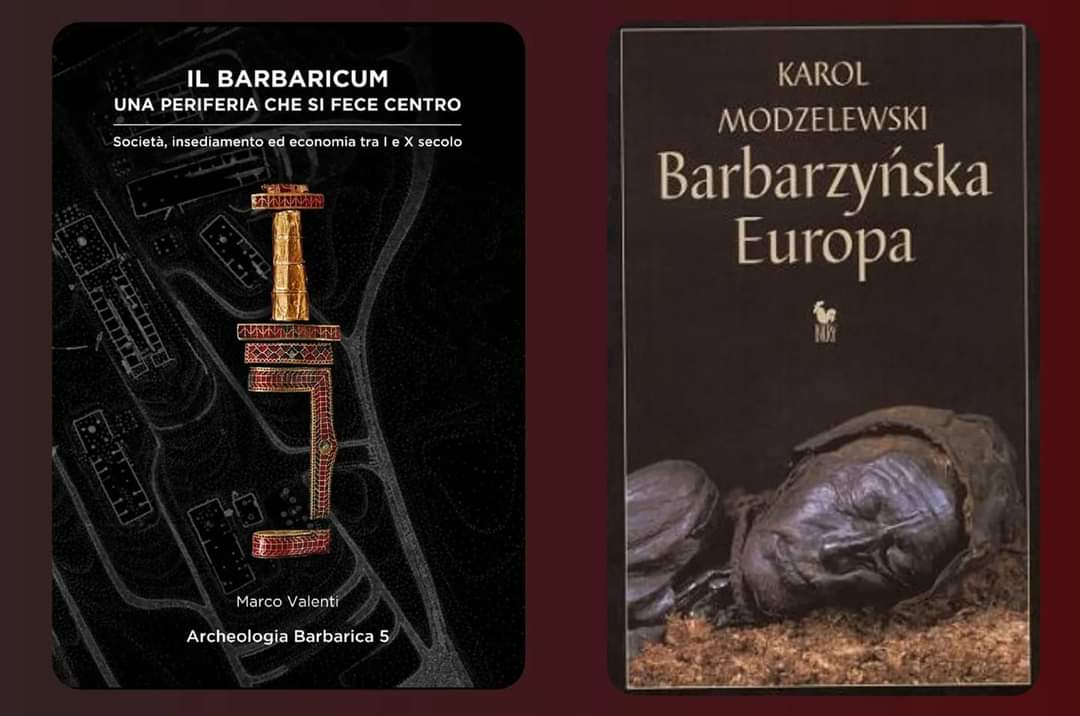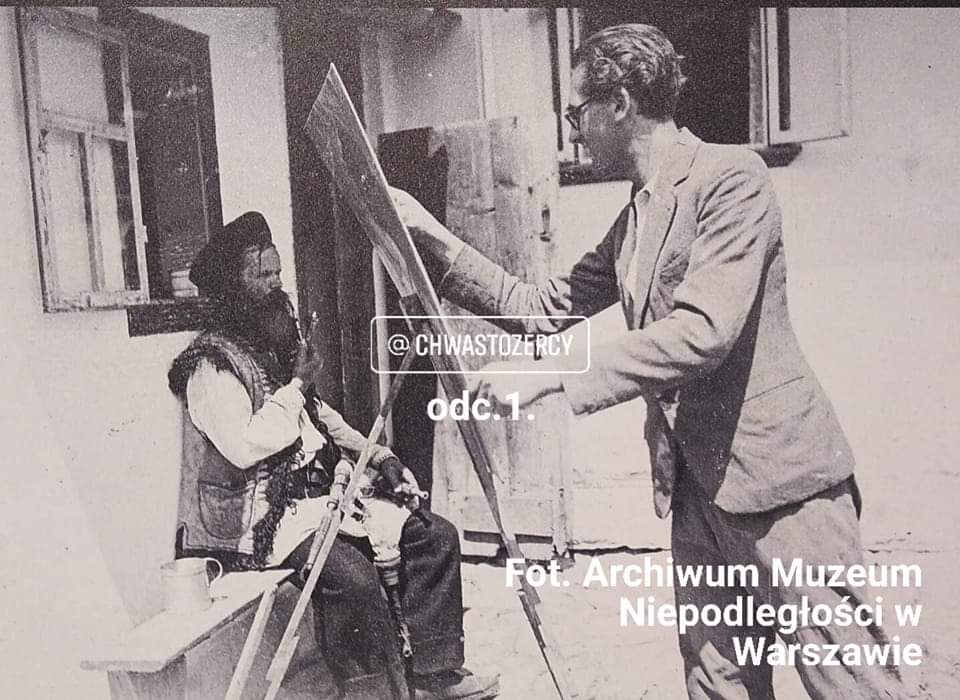🇵🇱🇬🇧 Fascynujące jest porównanie, jak bardzo różnią się spojrzenia na dane kultury i terytoria w zależności od punktu widzenia. Począwszy choćby od spisu spis treści (poniżej). Oto bowiem zestawienie dwóch opowieści: BARBARICUM versus BARBARZYŃSKA EUROPA. Szczególnie dziś wymowny jest fenomen interpretacji opisu kultury, bo świętujemy dziś 127 lat powstania Polskiego Towarzystwa Ludoznawczego.
🇬🇧 It is fascinating to compare how diverse views of given cultures and territories differ depending on the point of view. Starting at least from the table of contents (below). Here is a compilation of two stories: BARBARICUM versus BARBARZYŃSKA EUROPA (“Barbaric Europe”). The phenomenon of interpreting the description of culture is particularly expressive today, when we are celebrating 127 years of founding the Polish Ethnological Society.
*****
🇵🇱 Oto dwie książki opowiadające o Barbaricum, jakże różne. Jedna napisana przez Włocha, człowieka z obszaru ‘po Imperium’. Druga pisana przez Polaka, człowieka z obszaru ‘po Barbaricum’. Pierwszy autor – Marco Valenti – jest archeologiem, drugi – Karol Modzelewski – historykiem.
Podtytuł pierwszej jest szczególnie ciekawy: “Una periferia che si fece centro” – “Peryferie, które stały się centrum”. To zdanie doskonale podkreśla istotę interpretacji w uznaniu punktu widzenia, w ustaleniu układu współrzędnych opisu i… interpretacji dziejów.
Dla Italii Barbaricum zawsze było peryferiami, a ich ojczyzna była centrum, środkiem świata. Znamy to z własnego podwórka, bo to, co dla Polaków jest Kresami, dla mieszkańców owych “Kresów” jest centrum świata i absolutnie nie nazywali oni swej ojczyzny kresami – wielu uznaje to określenie za obraźliwe.
Italia postawiła się więc wówczas w centrum świata, a wszystko, co poza nią, było ‘barbaro’ – z greki barbaros “obcy, dziwny, ignorant”, z korzenia *barbar naśladującego niezrozumiałą mowę obcokrajowców – porównaj w sanskrycie: barbara- “jąkanie” również “niearyjski”, łacińskie balbus “jąkanie,” Tak powstały pojęcia ‘Barbaricum’ i ‘barbari’ (tłumaczeni na barbarzyńców).
Odwrotnie dla mieszkańców owego niesprecyzowanego administracyjnie Barbaricum (wszak nie był to homogeniczny twór państwowy ani etniczny), tj. np. Germanów, Gallów, Gotów, Celtów, Lugiów, Wandalów, Bastarnów, a potem i Słowian… i innych, “tych z Barbaricum” ewentualnie “pogan” – to właśnie imperium rzymskie było ‘poza’, było peryferiami ich centrum, czyli ojczyzny, ziem rozmaitych plemion i grup etnicznych (celowo mieszamy etnonimy o różnych zakresach).
Na tych opozycjach interpretacji zasadza się różnica perspektywy centrum i peryferii. Ten tytuł jest wspaniale antropologiczny i etnologiczny, jednocześnie podkreśla, że archeologia i historia są… względne, ksenogamiczne, a nawet nienaukowe w kontekście “szkiełka i oka” oraz kryteriów i decyzji, o których dalej.
Idąc dalej w różnice interpretacyjne: ciekawe, jaka byłaby interpretacja dziejów Barbaricum pisana przez kobiety, Włoszkę i Polkę archeolożkę i historyczkę. W dniu święta PTL, którego jesteśmy członkami, warto podkreślić niekonsekwencję w interpretacji dyscyplin nauki, które dotknęły naszą dyscyplinę: etnologię. Parę nierozgarniętych osób stwierdziło bowiem w 2018 roku, że… etnologia nie jest dyscypliną naukową.
Aż trudno uwierzyć w tak absurdalną tezę, lecz jako domena decydentów, stała się ona wykładnią decyzji politycznych i administracyjnych, a w efekcie finansowych i społecznych. Archeologia i historia pozostały oczywiście na liście dyscyplin naukowych, nie wiedzieć czemu, skoro są to dyscypliny interpretatywne, jak każda inna działalność intelektualna ludzi, tym bardziej tzw. uczonych. Sam tylko opis i klasyfikacja artefaktów oraz formułowanie tez, to już działanie interpretujące, wskazujące priorytety opisowe danej dyscypliny, konkretnego autora lub zespołu autorów.
Można nawet zarzucić archeologii i historii głęboką nieweryfikowalność ich tez, skoro: 1) archeologiczne teksty sprzed lat są już znacznie zdezaktualizowane i należy je przepisać od nowa, 2) artefakty są na nowo badane i dostarczają nowe wnioski, 3) rzekomo obiektywna historia oparta na faktach (!?), jako zespół tekstów tzw. tekstów żródłowych (!?), obciążona jest grzechem falsyfikatu, który udowodniono kluczowym tekstom uznawanym jednak nadal za wiarygodne źródłowe przez wielu konserwatywnych lub niezorientowanych historyków.
Obie te dość dyscypliny, z resztą jak i wszystkie inne, są interpretacjami rzeczywistości, która jest zmienna w zależności od punktu widzenia i układu współrzędnych – na szczęście, bo różnorodność jest zaletą i cechą niezbędną harmonii.
Czas więc przyznać, drodzy archeolodzy i historycy (i inni) wykluczający etnologię z grona dyscyplin naukowych, że jeśli według was, nas, etnologów, można oskarżyć za nienaukowość, to… jedziecie na tym samym chybotliwym wózeczku;)
🟢 A JEDNAK: #EtnologiaJestDyscypliną
Anna Maria Rumińska / architekt, antropolog kultury, rekonstruktorka i kuratorka kulinarna
*****
🇬🇧 Here are two books about the Barbaricum, how different. One written by an Italian, a man from the ‘post-Empire’ area. The second was written by a Pole, a man from the ‘after Barbaricum’ area. The first author – Marco Valenti – is an archaeologist, the latter – Karol Modzelewski – a historian.
The subtitle of the first book is particularly interesting: “Una periferia che si fece centro” – “Periphery That Have Become The Centre”. This sentence perfectly emphasizes the essence of interpretation in recognizing the point of view, in establishing the coordinate system of description and… interpretation of history.
For Italy, the Barbaricum has always been the periphery, and their homeland has been the centre of the world. We know it from our own backyard, because what is ‘Kresy’ (borderlands) for Poles, for the inhabitants of those ‘Kresy’ was/is the centre of the world and they absolutely did not call their homeland ‘borderlands’ – many find this term offensive.
Ancient Rome put itself at the center of the world, and everything outside of it was ‘barbaro’ – from Greek ‘barbaros’ meaning ‘foreign, strange, ignorant’, after the root ‘barbar’ – unintelligible speech of foreigners, Sanskrit ‘barbara’ as “stammering” or “non-Aryan”, Latin ‘balbus’ also as ‘stammering’. This is how the terms ‘Barbaricum’ and ‘barbari’ (translated then into barbarians) were born.
Conversely, for the inhabitants of that administratively unspecified Barbaricum (after all, it was not a homogeneous state or ethnic body), i.e., for example, the Germans, Gauls, Goths, Celts, Lugia, Vandals,Bastarnaes, and later Slavs… and many others, “those from the Barbaricum” or “pagans” – it was the Roman empire that was ‘beyond’, it was the periphery of their centre which was their homeland, the lands of various tribes and ethnic groups (we intentionally mix ethnonyms of different ranges).
The differences between the perspective of the centre and the periphery are based on these oppositions. This title is brilliantly anthropological & ethnological, while at the same time it’s emphasizing that archeology and history are … relative, xenogamic and even unscientific in the context of “glass and eye” and the criteria and decisions described further on.
Going deeper into the differences of interpretations: we wonder what the interpretation of the history of Barbaricum would be when written by women, an Italian and Polish archaeologist and historian. On the day of the PTL holiday of which we are members, it is worth emphasizing the inconsistency in the interpretation of the scientific disciplines that affected our discipline: ethnology. A few ill-witted people said in 2018 that… ethnology is not a scientific discipline.
It is hard to believe such an absurd thesis, but as the domain of decision-makers, it has become an interpretation of political and administrative decisions, and consequently financial and social ones. Archeology and history, of course, remained on the list of scientific disciplines, not knowing why, since they are interpretative disciplines, like any other intellectual activity of people, especially of researchers. The mere description and classification of artifacts and the formulation of thesis are already interpretative activity, indicating the descriptive priorities of a given discipline, a specific author or team of authors.
One can even accuse archeology and history that their theses are unverifiable, since: 1) archaeological texts from years ago are already significantly outdated and need to be rewritten or cancelled, 2) artifacts are newly examined and brought new conslisions, 3) allegedly objective history based on facts (!?), as a set of texts of the so-called written resources (!?), is burdened with the sin of counterfeit, which has been proven in key texts, however, still considered as reliable source by many conservative or ignorant historians.
Both of these disciplines, as well as all the others, are interpretations of reality are always shifting depending on a point of view and coordinate system – fortunately, since diversity is an advantage and a necessary feature of harmony.
So, it’s time to admit, dear archaeologists and historians (and others) who excluded ethnology from the group of scientific disciplines, that if according to you, we, ethnologists, may be accused to be unscientific, then… you are driving in the same truck:)
🟢 AFTER ALL: Ethnology is a discipline.
Anna Maria Rumińska / architect, cultural anthropologist, culinary reenactor & curator









